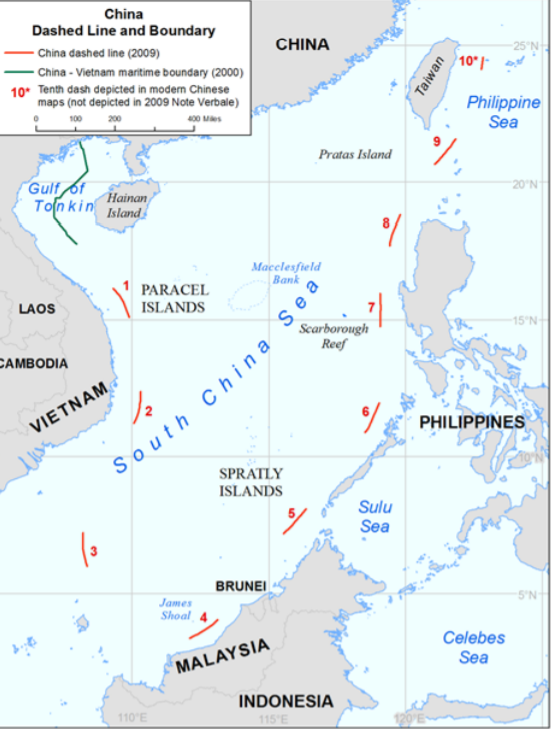China says that its imperial claims over the near entirety of the South China Sea are justified by history and political morality. There is no substance, historical or diplomatic, to these assertions.
Nevertheless, when it comes to rebutting Beijing’s ownership delusions in these most precious waters for trade, fishing, and energy production, it’s best to keep things simple. Geography helps us do so. The measure of a map proves that what China is doing is utterly at odds with even the most basic understandings of international law. I’ve observed this point before, but it’s worth considering the full extent of what China believes is its oceanic birthright. The so-called “nine-dash line” map below encompasses the area China today so ardently claims.

Just look at the distance between the southern tip of the nine-dash line at the James Shoal and the Chinese island of Hainan, just southwest of its mainland. From the James Shoal to Hainan is a distance of 1,000 miles. However, from the James Shoal to Malaysia is less than 70 miles. In essence, China is asserting that its inalienable sovereign rights extend 14 times further than Malaysia’s!
You’d think that China would have at least a pretense of a reasonable excuse for this bold agenda. That somewhere, sometime in the past, leaders from Brunei, Malaysia, Vietnam, and the Philippines must have agreed that China had ultimate sovereign control over at least a large element of the South China Sea.
Think again.
The nine-dash line map is merely the consequence of bold imagination and unbridled Chinese ambition. Following Imperial Japan’s defeat at the end of World War II, Chinese cartographers were instructed to draw up an 11-dash map claiming control over the South China Sea. While the Gulf of Tonkin area off the Vietnamese coast was later dropped from this map on Mao Zedong’s orders, the nine-dash area has remained. But it is far more the product of a man with a pencil than it is a divine right of Chinese communism. This needs to be said — because Beijing knows that if confronted with the facts, its arguments on the matter have far less value than first appears. Indeed, they appear for what they are: absurd.
Unsurprisingly, then, those nations most aggrieved by the nine-dash claims are those most opposed to it. Alongside the United States and Australia, and hopefully soon a number of other U.S. allies, these nations are moving to stand up for the rights and the foundation of international maritime law. The exception is fake Filipino strongman Rodrigo Duterte. Desperate to become Xi Jinping’s favorite poodle, Duterte has turned his navy into a quite literal beach patrol.
Still, for those unsure who is on the right side here, geography offers a very obvious answer.

